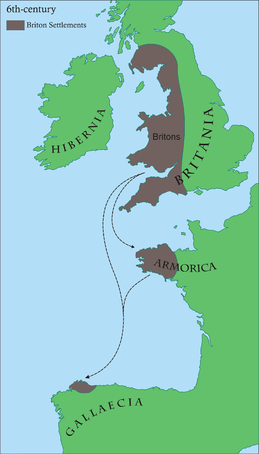Britonia

Britonia is the historical name of a settlement established in Gallaecia, northwestern Hispania, in the late 5th and early 6th centuries AD by Romano-Britons escaping the Anglo-Saxons, who were conquering Britain. Britonia is therefore similar to Brittany in Gaul in that it was settled by expatriate Britons at roughly the same time.
What little is known of Britonia is deduced from its religious history. The British settlements were recognised at the First Council of Lugo in 569 and a separate bishopric established. Mailoc was nominated Bishop of Britonia and signed the acta at the Second Council of Braga in 572. The British Celtic settlements were quickly integrated and their adherence to Celtic rite lasted only until the Fourth Council of Toledo in 633 decreed the now so-called Visigothic or Mozarabic rite as the standard liturgy of Hispania. The see of Britonia existed at least until 830 when the area was attacked by the Vikings; it may have continued as late as the Council of Oviedo in 900. It was finally merged with the Diocese of Mondoñedo-Ferrol. No longer a residential bishopric, Britonia is today listed by the Catholic Church as a titular see.[1]
Bishops
Known bishops of the ecclesia Brittaniensis include:
- Mailoc (Second Council of Braga, 572)
- Metopius (Fourth Council of Toledo, 633)
- Sonna (Seventh Council of Toledo, 646)
- Susa (Eighth Council of Toledo, 653)
- Bela (Third Council of Braga, 675)
References
- ↑ Annuario Pontificio 2013 (Libreria Editrice Vaticana 2013 ISBN 978-88-209-9070-1), p. 853
Sources
- Richards, Melville, "Mailoc", Habis, III, 1972, p. 159.
- Tovar, António, "Un obispo con nombre británico y los orígenes de la diócesis de Mondoñedo", Habis, III, 1972, pp. 155–158.
- Vives, J., Concilios visigóticos e hispano-romanos, Madrid, 1963.
- Young, Simon (Summer 2003). "The Bishops of the early medieval diocese of Britonia". Cambrian Medieval Celtic Studies (45): 1–20.
- Young, Simon, "Note on Britones in Thirteenth-century Galicia", Studia Celtica, XXXV (2001), pp. 361–2.
- Young, Simon, "The Forgotten Colony", History Today, L, oct. 2000, pp. 5–6.
- Young, Simon, "Britonia: Camiños Novos", Noia, 2002. ISBN 84-95622-58-0. (in Galician)
External links
- (English) Site dedicated to Britonia research
- (English) Present day Roman Catholic titular see of Britonia